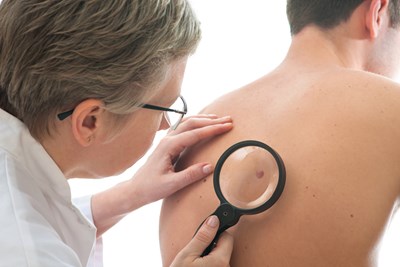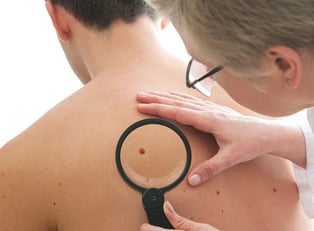Initial Treatment Options
Treatment options for skin cancer diagnoses will vary depending on the type of the tumor or pre-cancerous lesions. There are three different types of skin cancer: basal-cell carcinoma, squamous-cell carcinoma, and perhaps the best-known type, melanoma. The first two types are, by far, the most common forms of skin cancer. These two forms, while serious, do not typically spread. The third form, melanoma, is infamous because of its tendency to spread cancer throughout other areas of the body. Regardless of the type, there are many ways skin cancer can be treated with the appropriate option depending upon the size, depth under the skin, and location of the diagnosis.
The simplest form of treatment is for your doctor to perform a simple skin biopsy that will remove the entirety of the growth. This, however, is only effective for very early-stage skin lesions. In more advanced stages where the cancerous growth is larger, doctors may perform a procedure called cryosurgery. This noninvasive technique simply involves applying small amounts of extremely cold liquid nitrogen onto the tumor effectively killing the cancerous tissue. When the skin thaws, the dead tissue should slough off similar to a scab. Another option for cancers of any size or type is excisional surgery. During this procedure, the doctor uses a scalpel to cut the tumor from your body after applying a numbing agent. A small amount of healthier skin surrounding it the lesion may be cut as well. Sometimes a wider excision may be needed, depending on the type of skin cancer you have.
Another option for lesions on the top layers of skin is photodynamic therapy, the use of a combination of drugs and lasers that will make the cancer cells sensitive to light. This is often used in conjunction with other treatments. All of these treatments can help with all three types, especially melanoma.
Treatment Options for Advanced Conditions
If not all of the tumor can be removed by surgical procedures or is in more advanced stages, the more traditional cancer treatment of chemotherapy and radiation would likely be administered. With radiation treatment, X-rays are used to kill cancer cells. Chemotherapy usually involves medication given through an IV that destroys the cells. With skin cancers that are only on the top layer of skin, chemotherapy can also be a cream applied to the affected area. If the cancer has spread to other parts of the body, however, chemotherapy is given through an IV to destroy and prevent further cancerous growth.
Moh’s surgery may be used for basal- or squamous-cell cancers that have become too large for a simple excision or in the event of a reoccurring tumor. During this procedure, the doctor will remove the cancerous growth layer by layer. The doctor will study each layer under a microscope and only cease the procedure when he or she reaches a layer that is cancer-free.
Sometimes the excision will take away most of the cancer but small portions still remain. In this instance, the doctor may perform a procedure known as curettage, using a blade called a curet to scrape away the remaining cells. Sometimes, instead of a curet, the doctor will perform cryosurgery on the remaining cells, depending on the situation. These two procedures are quicker and easier than they may sound, and neither takes away a large amount of healthy skin cells.



